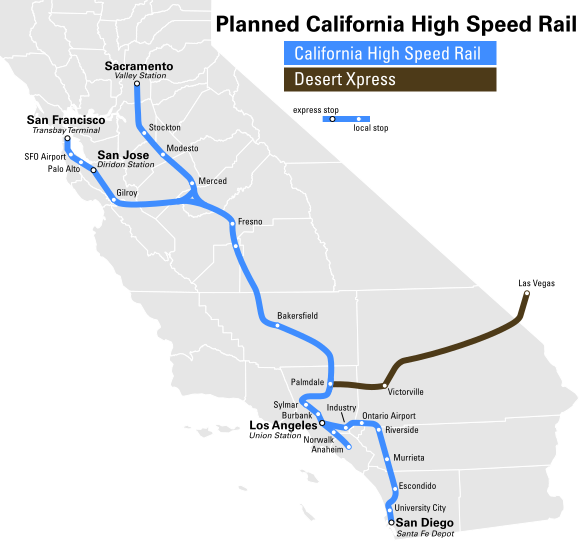| |
 Posted Apr 8, 2010, 6:03 PM
Posted Apr 8, 2010, 6:03 PM
|
|
BANNED
|
|
Join Date: Jun 2006
Location: San Francisco & Tucson
Posts: 24,088
|
|
|
California High Speed Rail Thread
Incredibly, I don't think a thread was ever started for CAHSR. It's past time so here it is.

Source: http://en.wikipedia.org/wiki/File:Cahsr_map.svg
California High Speed Rail Authority web site (many interactive features, renderings, videos and other goodies): http://www.cahighspeedrail.ca.gov/
Quote:
What is Proposition 1A?
Proposition 1A is the Safe, Reliable High-Speed Passenger Train Bond Act approved by voters on November 4, 2008. Voters were asked the following: “To provide Californians a safe, convenient, affordable, and reliable alternative to driving and high gas prices; to provide good-paying jobs and improve California's economy while reducing air pollution, global warming greenhouse gases, and our dependence on foreign oil, shall $9.95 billion in bonds be issued to establish a clean, efficient high-speed train service linking Southern California, the Sacramento San Joaquin Valley, and the San Francisco Bay Area, with at least 90 percent of bond funds spent for specific projects, with federal and private matching funds required, and all bond funds subject to independent audits?” . . . .
Will any Proposition 1A funds be used to improve current commuter, urban and intercity rail systems?
Yes. Proposition 1A provides for the allocation of $950 million of the total $9.95 billion in bond funds to eligible recipients for capital improvements to intercity rail ($190,000,000) and commuter rail and urban rail systems ($760,000,000). Eligible recipients are public agencies and joint powers authorities that operate commuter, light or heavy rail or cable car passenger services. The bond funds are to be used for capital improvements that provide direct connectivity to the high-speed train system, are part of the construction of the system, or that provide capacity enhancements, modernization, rehabilitation or safety improvements. Funds will be available upon appropriation by the Legislature in the annual Budget Act.
Intercity Rail - $190 M
Funds will be allocated for state-supported intercity rail lines by the California Transportation Commission (CTC) according to guidelines that the CTC will develop in consultation with the High Speed Rail Authority. Each of the state’s three intercity rail corridors (Capitol Corridor, San Joaquin Corridor, and Los Angeles-San Diego Corridor) will be allocated a minimum of 25% ($47.5 million) of the $190 million available.
Commuter and Urban Rail - $760 M
Funds will be allocated to eligible passenger rail agencies according to guidelines developed by the CTC, consistent with a statutory formula. Each recipient’s allocation will be a percentage amount based on the recipient’s share of three factors: 1) 1/3 based on the share of statewide total track miles, 2) 1/3 based on the share of statewide annual vehicle miles, and 3) 1/3 based on the share of statewide annual passenger trips. Recipients must provide a dollar-for-dollar local match and must maintain their previous annual average local expenditures for maintenance or rehabilitation of the passenger rail system so that the new funds supplement and do not replace existing funds for these purposes.
|
Source: http://www.cahighspeedrail.ca.gov/ne...=faqs&cat=8159
Quote:
What will it cost to build the California high-speed train system?
The most current estimated cost to build the 800-mile system is about $45 billion. Once built, the system will not require operating subsidies and will generate over $1 billion in annual profits.
Where will the financing come from?
The Authority awarded a Financial Planning contract in late 2006 to a team of financial experts. In May 2007, the Authority published the “High-Speed Train Preliminary Funding Strategy and Financing Plan”. This plan concluded that the project’s funding will likely comprise of private and public sources; however, support from local, state and federal sources will be particularly important in early development. It also concluded that the State can issue the $9.95 billion in GO debt scheduled on the November 2008 ballot, without exceeding the Administration’s current debt capacity guidelines.
The California High-Speed Rail Authority is actively pursuing a multi-track financing strategy for the planning, design and construction phases of the project, including three tiers: state and local funding, federal funding and “P3”- public-private partnerships.
State and Local Funding: $9.95 billion general obligation bond (Proposition 1A) . . . .
Federal Funding: Federal matching funds are expected to finance a significant portion of the construction cost. The targeted federal funding would come in part from existing program funding sources, but would also require the creation of new grant allocation programs designed specifically for high-speed trains. On October 30, 2007, the United States Senate passed the Passenger Rail Investment and Improvement Act of 2007, a multi-year piece of legislation that provides increased funding for the nation's rail system. This bill (H.R. 2095) was signed by President Bush on October 16, 2008 and creates a framework to provide a direct means of funding high-speed trains that had not existed at the federal level . . . .
(California HSR received approximately $2.5 billion of federal "stimulus" funding.)
Public-Private Partnerships “P3” Funding: The Authority’s finance team anticipates that the commitment of state and federal dollars will attract private sector funding. The Authority’s finance team has identified a broad array of public-private partnership opportunities, including project debt financing, vendor financing, system operations and private ownership.
In March 2008, the Authority announced the release of a Request for Expressions of Interest (REFI) for Private Participation in the Development of a High-Speed Train System in California. Through the responses to the REFI, the Authority gained a better understanding of how the Project and State can benefit from private sector participation while also garnering an appreciation for key considerations that may encourage or dissuade private sector participation, such as phasing, timing and risk. The Authority sought input from respondents as to potential interest in participating in the development aspects of a high-speed train system, including perspectives on project delivery methods and private project financing.
|
Source: http://www.cahighspeedrail.ca.gov/ne...=faqs&cat=8173

|
|
|



